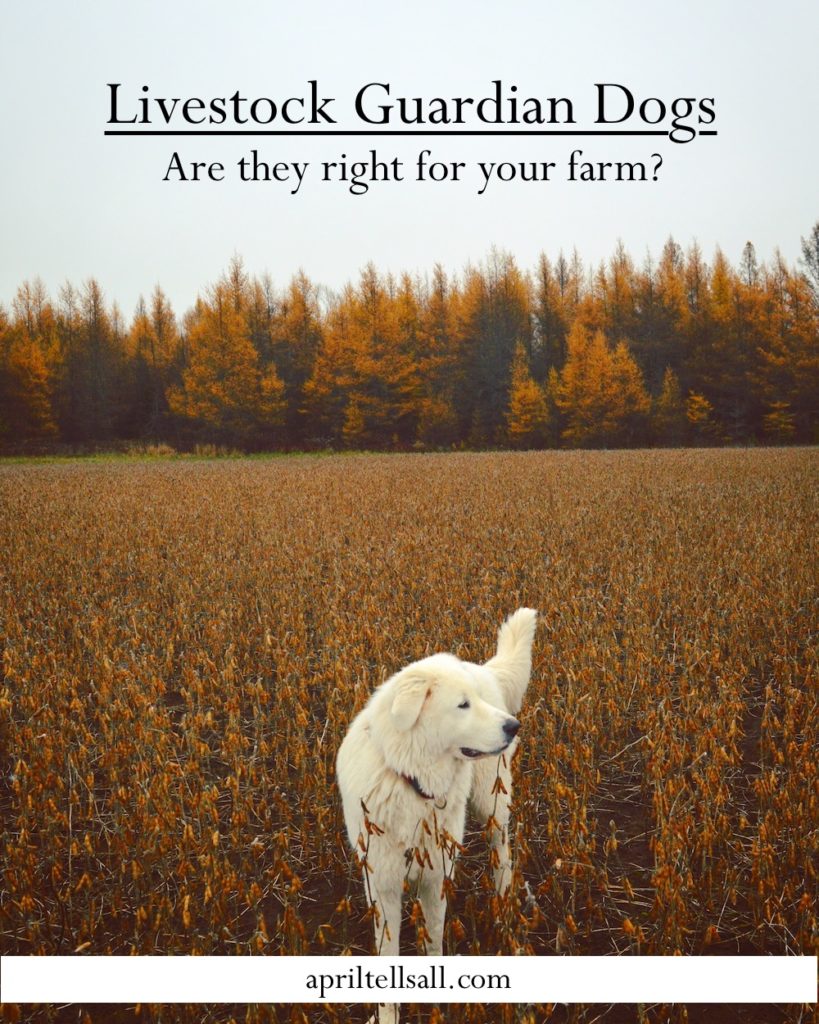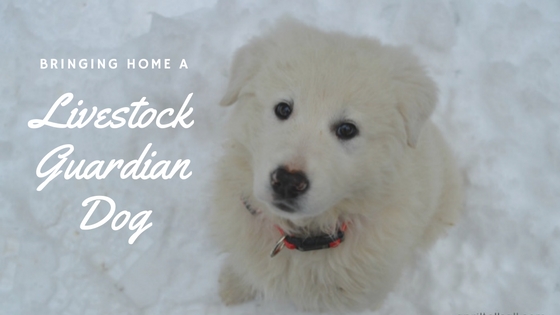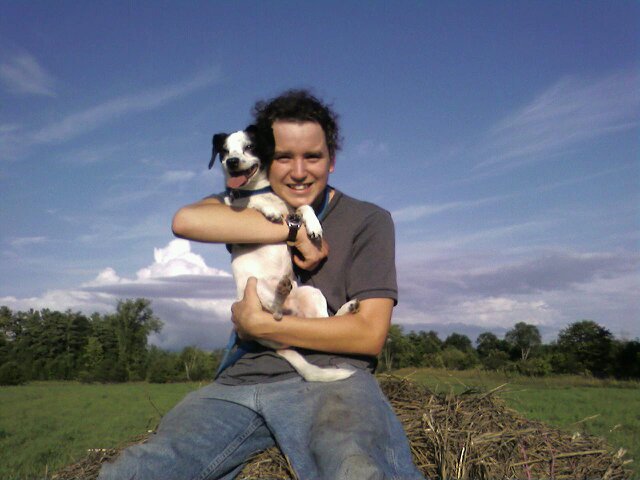I wrote my original post about Livestock Guardian Dogs back when we brought home our first Maremma sheepdog, Hayley. Back when I knew the research but hadn’t lived the experience.
While I still stand by the training techniques I talked about in that post, I figured it was high time I revisited the realm of Livestock Guardian Dogs (or LGD for short) and share some of the hard lessons I’ve learned. (I was going to say wisdom but thought that sounded a little “la-tee-da”.)
First you need to meet my dogs.
I have two maremma sheepdogs who work full time on our farm.

Hayley is two and half and considered an adult. She is fully trained to chickens (the hardest livestock to get a dog to guard) as well as goats and cattle. Hayley’s weakness is rabbits. She is gentle and very sensitive. She’s the scout in my pair of dogs. Hayley weighs in at 120 pounds. She was named after “Hayley” the MI6 agent from the show Castle season 8.
Mathias is 8 months old and is considered a teenager. The teenage phase can be very challenging or very easy depending on the dog. Hayley went through a rough teenage phase, whereas Mathias has been a dream. He was a challenge at 4 months old but seems to have since come out of it (knock on wood). Mathias works full time with the goats and cattle. He is not chicken safe and will eat them if given the opportunity. He also hates rabbits. Mathias will be the muscle of the pair. While Hayley scouts, Mathias will hang back to guard the stock but should Hayley alert to something, it’s Mathias that will charge. He is brave, gentle, and very calm. At 8 months old he is just a few inches shy of Hayley’s height and is quite long. Once he fills in I expect he’ll be a big boy. Mathias currently weighs 80 pounds. Mathias was named after the reservation police chief from the show Longmire.
Our predator load consists of (listed in order of most persistent)
- fox
- bobcat
- coyote
- racoon
- fisher/weasel family in general
- bear
- wolf
What is a Livestock Guardian Dog?
Firstly, a livestock guardian dog is a breed type (like hunting dog or herding dog) not a job description and this is where a lot of people get confused. Even I was confused at first. In my first post you see me talk about Bowser my akita border collie mix as a livestock guardian. Bowser, while a good guard, does not classify as a livestock guardian dog. So what does that term actually mean? A livestock guardian is a specific class of breeds that have bred over thousands of years to protect livestock. They live full time with their stock. 24/7. They have been developed to be individual thinkers. Their desire to protect the flock or herd comes instinctively because they’ve been bonded since an early age. These dogs bond very closely to their charges and will bond to their owners as well. An issue can arise when the dog becomes more bonded to the owner than the livestock.
Here’s a few of the breeds to consider when thinking about purchasing a LGD.
- Maremma Sheepdog
- Great Pyrenees
- Anatolian Shepherd
- Komodor
- Kangal
- Tornjak
- Armenian Gampr
- Central Asian Shepherd
- Kuvasz
- Pyrenean Mastiff
- Sarplainic
There’s many more but that’s just a few of the more popular breeds. Be sure to do your research thoroughly as each of these breeds have individual traits and vary in aggression. If your farm has lots of visitors you may not want a Central Asian Shepherd, but a Great Pyrenees or Anatolian might be a better fit, and so on. Be sure you completely research the breed characteristics and traits before deciding.
[wp_ad_camp_1]
Training
I’ve never had to train a dog to guard. These dogs instinctively know how to guard. Their desire to guard comes from their bond to their charges. When bringing home a livestock guardian be it a puppy or a mature dog, you must leave the dog with the stock. The bond happens relatively early with puppies. It is sometimes best to have the dog in a kennel or stall where they can see the livestock but can’t get to them. This is as much for the livestock as it is for the dog. My goats can be a bit rough on puppies.
Training for a livestock guardian dog takes place in the form of corrections. You want to correct unwanted behaviour (ie: chasing livestock, barking excessively) and encourage good behaviour (being calm, displaying submissive body language). With my dogs I have found that you shouldn’t just correct all the time. As big and nacho as these dogs come across, they’re actually big softies and need to know they’re doing something right as much as when they’re doing something wrong. I praise often for good behaviour.
Corrections:
When I need to correct a dog, the first step I take is verbal command. If a dog is chasing a goat I firmly yell (Name of dog) Enough!
If the dog ignores me and continues the unwanted behaviour I grab the dog by the collar and put him/her into a sit. (Please note that my dogs don’t wear collars full time. Collars can get caught on things or can be grabbed by predators. My young puppies wear collars for training purposes only and have no collars when they’re fully trained, except for vet visits or when they need to be tethered)
If the dog is still interested in bad behaviour or goes straight back to chasing after steps one and two, the dog is removed from the area for a time out. Very rarely have I had to resort to time outs and while Hayley seemed to actually like them, Mathias was devastated the one and only time I’ve ever had to put him on a time out.
Care
LGDs need the same care as any dog. They’re quite easy to care for as they live outside full time. They need a good draft free shelter (that they’ll rarely use), fresh water, good food, vaccinations, and flea and tick medication. Their coats are relatively care free, but the occasional mat will need to be brushed out as well as burrs or bramble that gets caught in their hair. In the Spring they will “blow their coat” which means they shed out their double coat. Brushing them out helps a lot with this. Hayley is prone to ear infections so her ears get washed regularly during the wet season (she likes to lay in puddles).
Do not shave a LGD no matter how hot it gets in the summer. The double coat is there to protect them in the summer just as much as in the winter. In the summer make sure they have ample shade, lots of fresh water, and some even enjoy a kiddie pool. My dogs dig deep holes into the ground that they lie in to help keep themselves cool. (That my ankle has found many times in the dark!)
We take our dogs to an off farm vet. This allows some “time off” and socializing. Both dogs are very well behaved off the farm, however they can only handle small doses. They do tend to get anxious when away from their charges for long periods of time. Both of my dogs are (or are going to be) fixed. Hormones can be a distraction, and we have no desire to add to the unwanted puppy population. Because these dogs are classified as “giant” they do need some extra time to mature before they’re fixed. We spayed Hayley at 10 months because we did not have a way to contain her should she go into heat. There was also unfixed males in the area that we didn’t want to attract. This was the best we could do in our situation. Mathias will be neutered closer to two years old, as long as he doesn’t start showing aggressive traits. Spay/Neuter is a hot topic so I suggest you do your own research and talk to your vet to get a plan that works best for your situation. During coyote breeding season we had to be extra vigilant about keeping Mathias in the fenced area as he would take off easily, being able to smell coyote bitches in heat.
Pros & Cons
LGDs are individual thinkers. Which means that they will hear your command but will decide for themselves if they want to follow it or not. They do not wish to please you the way that a collie or retriever does. They will make their own decisions based on how they view a situation. You are their partner not their master. All this to say that they don’t listen very well. If you want a dog that heeds your every command – a LGD is not it. But this is also a good trait. The dog can think for itself and can handle a situation without you being there to tell it what to do.
They bark, usually at night as that’s when most predators are active. This can be an issue with neighbours.
You will need good fences as most dogs are prone to wandering. They do this to expand their territory mostly and look for threats, but a roaming dog is a target. I do not allow our dogs to roam. They are fenced at all times. We use a combination of electric and 5 ft. field fence.
They do an excellent job. We have no losses with the dogs on the job. This has given us so much more freedom. With small livestock, predators are always a concern, but when we’re off the farm I know Hayley and Mathias are on the job. They’re my lifesavers in a lot of ways. They protect my investments, and a trustworthy dog is worth their weight in gold.
Still thinking you need a livestock guardian dog?
I couldn’t farm without our dogs. However, I would be doing you a disservice if I didn’t mention the teenager phase. These dogs mature at about 2 years old. Until that point (and sometimes even after) you will go through a lot of phases. The worst known as “the teenager phase”. Where they test you constantly. This is the time when the dog has a puppy brain but an adult body. They can do serious damage to livestock while in this phase. They really don’t listen during this phase and you have to be consistent and serious in your corrections.
A few things to help you through this phase:
- Wear that dog out! Exercise, exercise, exercise! Hayley and I went on long walks when she was a teenager. We would walk close to two hours a day.
- Tether. I am not against tethering a dog when it’s done safely. Make sure they can’t get tangled up or around anything. Tethering is fantastic because it allows the dog to stay with the livestock but the livestock can get out of reach of the dog. Both of my dogs are tether trained. It’s easier when the vet comes to check the livestock, or for when we have visitors (Hayley dislikes children so we tether her when having young kids on the farm that want to see the animals).
- Lots of play time. Hayley was my first LGD and because she was alone she didn’t get to have puppy play. I allowed puppy play outside of the livestock pen with my house dogs. Wrestling, chasing, and barking with other dogs allowed her to get her energy out in a safe way. With Mathias, he has Hayley to play with which has helped tremendously with his puppy energy.
And finally a few words of advice.
- Train one puppy at a time. Don’t get two at the same time. One puppy is enough trouble. Having an older trained dog when you bring on the second puppy will help you a ton! The younger dog will want to be like the older dog and mimic the behaviour. Two puppies will feed off each other and get into all sorts of mischief.
- Male/Female teams work the best together. Two males can work well too. Two females are more prone to fighting.
- When you’re in the midst of the teenage phase and just about ready to pull your hair out and you can’t believe you’ve gotten yourself into this mess, take a deep breath. This too shall pass.
Hayley and Mathias are the royalty of the farm. I could not farm without them here. They’re friendly, affectionate, trustworthy, and fantastic guardians. I love having them on this farm more than some of the other animals. (I’m looking at you, goats!) While it can be at least a two year commitment until they’re fully trustworthy, I truly believe livestock guardians are worth the time it takes to raise them up.
More Resources:
My First Post on Livestock Guardians – April Tells All
You’ll recognize some faces in this article! – That Mutt
Some Bragging About Hayley – April Tells All















Thanks so much for posting about LGDs. We have a small sheep herd and a 1-year-old Anatolian/Pyrenees. Our experience seems to mirror yours closely, since we didn’t have an older dog to help train the puppy, or even other dogs to help use up her energy. She’s matured and learned a lot in the months we’ve had her, and so have we. Finding info and resources to help guide us, especially during her adolescence, has been challenging, which is why I was intrigued by your posts. (I found your blog while researching the benefits of bee pollen. It seems we share more than one interest!) I look forward to reading your past (and hopefully future) posts as I’m sure there’s always more to learn about these amazing creatures. Blessings to you and yours.